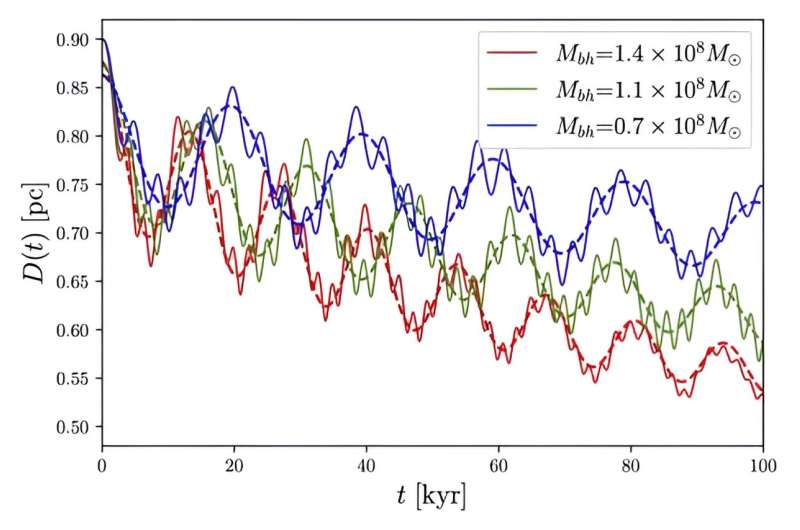This article has been reviewed according to Science X's editorial process and policies. Editors have highlighted the following attributes while ensuring the content's credibility:
fact-checked
preprint
trusted source
proofread
Dark matter could help solve the final parsec problem of black holes

When galaxies collide, their supermassive black holes enter into a gravitational dance, gradually orbiting each other ever closer until eventually merging. We know they merge because we see the gravitational beasts that result, and we have detected the gravitational waves they emit as they inspiral. But the details of their final consummation remain a mystery. Now a new paper published on the pre-print server arXiv suggests part of that mystery can be solved with a bit of dark matter.
Just as the famous three-body problem has no general analytical solution for Newtonian gravity, the two-body problem has no general solution in general relativity. So, we have to resort to computer simulations to model how black holes orbit each other and eventually merge.
For binary black holes that are relatively widely separated, our simulations work really well, but when black holes are close to each other things get complicated. Einstein's equations are very nonlinear, and modeling the dynamics of strongly interacting black holes is difficult.
As a result, the simulations we do have don't show the black holes merging. Instead, they inspiral until they are about a parsec apart, then stabilize. This is known as the final parsec problem.
One idea to solve the problem is to introduce dark matter into the mix. After all, cold dark matter is nearly everywhere according to the standard cosmological model, so it likely plays a role in the mergers of supermassive black holes. But so far it seems cold dark matter isn't the answer. Simulations using it have the same final parsec problem as general relativity alone.
In this new study, the team considers a variation on dark matter known as fuzzy dark matter. It's similar to standard cold dark matter except it is made of low-mass scalar particles. Since these particles wouldn't interact with each other by anything other than gravity, they wouldn't clump in quite the same way as regular dark matter, and thus have a more "fuzzy" distribution.
Fuzzy dark matter was first proposed to address what is known as the cusp problem of dwarf galaxies, which is a weak point for dark matter. Here the authors show that fuzzy dark matter can increase the rate of orbital decay for black holes, particularly the largest of supermassive black holes. It could explain some of the monsters we've observed at the heart of some elliptical galaxies.
But the work doesn't prove fuzzy dark matter is the solution. The details of the final stage of inspiraling black holes are still, shall we say, a bit fuzzy. It will take direct observations of supermassive black holes to either prove or rule out the idea. Fortunately, future NANOGrav observations, or those of the planned LISA gravitational wave observatory should be able to see such mergers. Then our understanding of how the largest black holes in the cosmos merge won't be quite so fuzzy.
More information: Hyeonmo Koo et al, Final parsec problem of black hole mergers and ultralight dark matter, arXiv (2023). DOI: 10.48550/arxiv.2311.03412
Journal information: arXiv
Provided by Universe Today




















